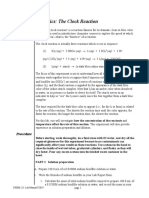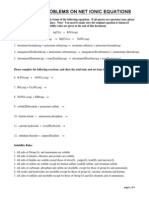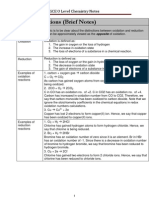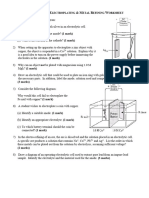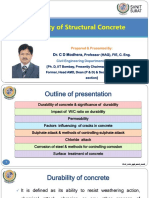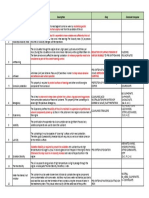Qualitative Analysis
Qualitative Analysis
Uploaded by
Yukeling TayCopyright:
Available Formats
Qualitative Analysis
Qualitative Analysis
Uploaded by
Yukeling TayOriginal Description:
Copyright
Available Formats
Share this document
Did you find this document useful?
Is this content inappropriate?
Copyright:
Available Formats
Qualitative Analysis
Qualitative Analysis
Uploaded by
Yukeling TayCopyright:
Available Formats
Testing for cations
Cations can be identified by their reactions with aqueous sodium hydroxide and aqueous ammonia
A precipitate is an insoluble solid.
When testing for cations, these precipitates only form when a metal ion in solution joins with hydroxide ions in
solution to form an insoluble metal hydroxide
o eg Cu2+ + 2OH- --> Cu(OH)2 (blue copper(II) hydroxide precipitate)
Add dilute NaOH Add excess dilute Add dilute aqueous NH3 Add excess dilute aqueous
Cation
(5 drops) NaOH (5 drops) NH3
ppt dissolves white ppt of aluminium
Al3+ white ppt of aluminium hydroxide ppt insoluble
colourless solution hydroxide
Ca2+ white ppt of calcium hydroxide ppt insoluble no reaction no reaction
blue ppt of copper(II) ppt dissolves
Cu2+ blue ppt of copper(II) hydroxide ppt insoluble
hydroxide deep blue solution
dirty green ppt of iron(II)
Fe2+ dirty green ppt of iron(II) hydroxide ppt insoluble ppt insoluble
hydroxide
red-brown ppt of iron(III)
Fe3+ red-brown ppt of iron(III) hydroxide ppt insoluble ppt insoluble
hydroxide
ppt dissolves white ppt of lead(II)
Pb2+ white ppt of lead(II) hydroxide ppt insoluble
colourless solution hydroxide
ppt dissolves white ppt of zinc ppt dissolves
Zn2+ white ppt of zinc hydroxide
colourless solution hydroxide colourless solution
ammonia gas is produced on warming
with dilute NaOH. This gas has a
NH4+ - no reaction -
pungent smell and turns moist red
litmus paper blue
1. Copper(II) is blue; Iron (II) is green; Iron (III) is reddish brown; the rest form white precipitate and if soluble in excess,
becomes colourless solution;
2. Zinc(Zn), aluminium(Al), and lead (Pb) form precipitates that are soluble in excess sodium hydroxide [ or you can
remember it as ZAP dissolves in excess NaOH];
3. Copper(II) and zinc ions form precipitates that are soluble in excess aqueous ammonia;
4. Ammonium and calcium form no precipitate when aqueous ammonia is added;
5. Test for ammonium ion is slightly different (you add sodium hydroxide, and heat. Ammonia gas is evolved if
ammonium ions are present).
6. [Lead(II) ions can be distinguished from aluminium ions by the insolubility of lead(II) chloride.]
Colours of some metal hydroxides
Metal hydroxide Colour
calcium hydroxide white
copper(II) hydroxide light blue
iron(II) hydroxide green
iron(III) hydroxide red-brown
lead(II) hydroxide white
zinc hydroxide white
Testing for anions
Anion Test Test result
Carbonate (CO32-) Add dilute acid Effervescence, carbon dioxide produced
Chloride (Cl-) Acidify with dilute nitric acid, then add aqueous silver
White ppt
(in solution) nitrate
Iodide (I-) Acidify with dilute nitric acid, then add aqueous lead(II)
Yellow ppt
(in solution) nitrate
nitrate (NO3-) Add aqueous sodium hydroxide, then aluminium foil, warm
Ammonia produced
(in solution) carefully
Sulfate (SO42-) Acidify with dilute nitric acid, then add aqueous barium
White ppt
(in solution) nitrate
Testing for gases
If gas is produced from a solution, describe it this way:
o Effervescence of (colour), (smell) gas, (effect on damp litmus paper), distinguishing test.
o e.g. Effervescence of colourless, odourless gas, has no effect on both damp blue and red litmus paper.
Relights a glowing splint. [for oxygen]
If a gas is produced from a solid, you will not see any bubbles, so describe this way:
o (colour), (smell) gas, (effect on damp litmus paper), distinguishing test.
a. Identify A to F.
b. Write an ionic equation (with state symbols) for the formation of the yellow precipitate.
c. Describe a test for the pungent gas R.
d. Pungent gas R dissolves in water to form a solution. Describe the observations when a few drops of
copper(II) sulphate solution is added to the solution.
In the experiment shown below, the gas X produced by the action of dilute sulphuric acid on the zinc granules
was passed over two heated metallic oxides. A colourless liquid W was collected and the excess gas X was
burnt off at Y.
a. What is gas X? Write the ionic equation for the formation of the gas.
b. State what is observed of:
i. zinc oxide
ii. copper(II) oxide
Write equation(s) for any change observed.
c. Explain your observation made in bi and bii.
d. Give a chemical test to identify liquid W.
e. Suggest a suitable drying agent to be placed inside the drying bulb.
f. Why was the excess gas X burnt off at Y?
g. What precautions should be taken before the excess gas was lit?
You might also like
- Structure 1. Models of The Particulate Nature of MatterDocument9 pagesStructure 1. Models of The Particulate Nature of MatterAli Mohamed ShiplNo ratings yet
- CHEM 121: Kinetics: The Clock ReactionDocument11 pagesCHEM 121: Kinetics: The Clock ReactionMuthiani Denis100% (1)
- SNEFERU - Architectural ReviewerDocument58 pagesSNEFERU - Architectural ReviewerPia Eleanor Santos100% (11)
- BS en 00410-1998 PDFDocument28 pagesBS en 00410-1998 PDFShan Sandaruwan AbeywardeneNo ratings yet
- 2015 Combined Chem O Level 5078/03 AnswersDocument8 pages2015 Combined Chem O Level 5078/03 AnswersMethodology OfStudies100% (2)
- Mdcat Past Papers 2010-2021 172 Pages READYDocument172 pagesMdcat Past Papers 2010-2021 172 Pages READYTalha Samad Khan0% (1)
- Combined Chemistry Booklet 3Document24 pagesCombined Chemistry Booklet 3api-422428700No ratings yet
- Solubility Rules: Name - Chem Worksheet 15-1Document1 pageSolubility Rules: Name - Chem Worksheet 15-1Mohamed El-sherbinyNo ratings yet
- Lab 2 - Separating A Sand and Salt MixtureDocument3 pagesLab 2 - Separating A Sand and Salt MixtureTonyDiazNo ratings yet
- Experiment 12 TLC Analysis of Analgesic DrugsDocument4 pagesExperiment 12 TLC Analysis of Analgesic Drugsthissisnate67% (3)
- 3 Experiment ChemistryDocument30 pages3 Experiment ChemistryThangavel SarujanNo ratings yet
- Notes For Use in Qualitative Analysis-1Document2 pagesNotes For Use in Qualitative Analysis-1Nehara FernandoNo ratings yet
- Collated Acids AnswersDocument9 pagesCollated Acids AnswersmadonnaNo ratings yet
- 1.1.3 Exercise 1 - Water of CrystallisationDocument1 page1.1.3 Exercise 1 - Water of CrystallisationAtulya BharadwajNo ratings yet
- Identifying Cations FlowchartDocument1 pageIdentifying Cations FlowchartJeffrey PiggottNo ratings yet
- Practice Problems On Net Ionic EquationsDocument3 pagesPractice Problems On Net Ionic EquationsZainabNo ratings yet
- 1.1.3 Exercise 1 - Water of CrystallisationDocument1 page1.1.3 Exercise 1 - Water of Crystallisationaya abdulfattahNo ratings yet
- Electrolysis WorksheetDocument2 pagesElectrolysis WorksheetPranav ChiploonkarNo ratings yet
- Electroysis WorksheetDocument2 pagesElectroysis WorksheetericaNo ratings yet
- Edexcel IAS Energetics 1Document14 pagesEdexcel IAS Energetics 1mostafa barakatNo ratings yet
- CHP 6 - Identification of Ions & Gases (Multiple Choice) QPDocument10 pagesCHP 6 - Identification of Ions & Gases (Multiple Choice) QPDhrumeel100% (1)
- Chapter 7: Acid and Base SECTION A: Common Mistake Made by The CandidatesDocument17 pagesChapter 7: Acid and Base SECTION A: Common Mistake Made by The CandidatesHamidah Mohd YusofNo ratings yet
- Redox ReactionsDocument2 pagesRedox Reactionschong56No ratings yet
- CSEC Qualitative of CationsDocument2 pagesCSEC Qualitative of CationsscasimirNo ratings yet
- Csec Chemistry Chapter 8 - Oxidation-ReductionDocument12 pagesCsec Chemistry Chapter 8 - Oxidation-Reductionchelsea AlexandriaNo ratings yet
- Grade 10 Chemistry Lab ManualDocument18 pagesGrade 10 Chemistry Lab Manualsaanvi reddyNo ratings yet
- Criteria Based WorksheetDocument3 pagesCriteria Based Worksheetarun iyer BitcoinminerandmathematicianNo ratings yet
- Periodic Table - Edexcel IgcseDocument1 pagePeriodic Table - Edexcel IgcseElmar AmirovNo ratings yet
- Periodic Table IBDPDocument1 pagePeriodic Table IBDPCassidyNo ratings yet
- Acids and Bases Unit Test 2011Document8 pagesAcids and Bases Unit Test 2011jkdfal1No ratings yet
- Sats QuestionsDocument9 pagesSats Questionsapi-3800318No ratings yet
- Sample: Observations: Infrences: ADocument2 pagesSample: Observations: Infrences: AtahjsalmonNo ratings yet
- IGCSE Chemistry Oxygen Hydrogen and Carbon DioxideDocument15 pagesIGCSE Chemistry Oxygen Hydrogen and Carbon DioxideS M AkashNo ratings yet
- Edexcel IAS Bonding 1Document14 pagesEdexcel IAS Bonding 1mostafa barakatNo ratings yet
- Preparation of SaltsDocument6 pagesPreparation of Saltssakibsultan_308No ratings yet
- SC20b - Fractional-Distillation-Worksheet 2Document1 pageSC20b - Fractional-Distillation-Worksheet 2silviaNo ratings yet
- Balancing Redox Reactions Equations Practice With AnswersDocument4 pagesBalancing Redox Reactions Equations Practice With AnswersCarmenNo ratings yet
- Form 2 Chemistry Physical and Chemical Changes PDFDocument6 pagesForm 2 Chemistry Physical and Chemical Changes PDFivanna pierreNo ratings yet
- Halogens Practical ReportDocument5 pagesHalogens Practical ReportTyson SmithNo ratings yet
- WORKSHEET: Redox Reactions: Oxidation (O) or Reduction (R) ReactionDocument2 pagesWORKSHEET: Redox Reactions: Oxidation (O) or Reduction (R) ReactionMuhammad TalhaNo ratings yet
- Testing Inorganic Compounds - Practical NotesDocument3 pagesTesting Inorganic Compounds - Practical NotesMairaNo ratings yet
- in An Experiment To Find The Enthalpy Change When Copper Is Displaced From A Solution of Copper Ions Excess ZincDocument8 pagesin An Experiment To Find The Enthalpy Change When Copper Is Displaced From A Solution of Copper Ions Excess ZincJake RobinsonNo ratings yet
- 2 - Acids, Bases and SaltsDocument8 pages2 - Acids, Bases and SaltsSuresh Kumar SharmaNo ratings yet
- Moles IB 1 PDFDocument10 pagesMoles IB 1 PDFBita M100% (1)
- Reactions of Acids Homework Worksheet HADocument3 pagesReactions of Acids Homework Worksheet HASarah KKCNo ratings yet
- CH 10 Salts & Its PreparationDocument25 pagesCH 10 Salts & Its Preparationapi-3774259100% (7)
- Chapter 8 Chemical Reactions and EquationsDocument10 pagesChapter 8 Chemical Reactions and EquationsgustafNo ratings yet
- Salt PreparationDocument26 pagesSalt PreparationMenaga A/P IlangkovanNo ratings yet
- 2.1 Exercise 1 - Measuring Enthalpy ChangesDocument1 page2.1 Exercise 1 - Measuring Enthalpy Changesjuwairiahkhan78981No ratings yet
- Chemistry Worksheet 2Document8 pagesChemistry Worksheet 2Marie BozemanNo ratings yet
- ExperimentDocument16 pagesExperimentcloudx chimNo ratings yet
- Unit 1 Moles and FormulaeDocument3 pagesUnit 1 Moles and FormulaeVeraNo ratings yet
- Lab Report On Oxidation and ReductionDocument7 pagesLab Report On Oxidation and ReductionkasuleNo ratings yet
- METALS and NON-METALSDocument24 pagesMETALS and NON-METALSTushti Ramlogan100% (1)
- Apparatus - Worksheet 1: Write The English Names Under Each PictureDocument3 pagesApparatus - Worksheet 1: Write The English Names Under Each Picturemenaga ilangkovanNo ratings yet
- Redox: Question Paper1Document17 pagesRedox: Question Paper1Uzair ZahidNo ratings yet
- Electroplating WorksheetDocument2 pagesElectroplating WorksheetHồ Thị Ngọc MinhNo ratings yet
- 'O' Level Chemistry Paper 1 - 2012Document16 pages'O' Level Chemistry Paper 1 - 2012MayureshSoowamberNo ratings yet
- N m05 21Document1 pageN m05 21David MathagaNo ratings yet
- Chem G-9 Lesson 7 IGCSE Qs - Rates of ReactionDocument24 pagesChem G-9 Lesson 7 IGCSE Qs - Rates of ReactionKarim Wael100% (1)
- O Level Biology Practice Questions And Answers HomeostasisFrom EverandO Level Biology Practice Questions And Answers HomeostasisRating: 5 out of 5 stars5/5 (1)
- Test For Gases: Gas Test and Test ResultsDocument2 pagesTest For Gases: Gas Test and Test ResultsKhim YangNo ratings yet
- CH 1 Identification Ions and Gases For StudentDocument4 pagesCH 1 Identification Ions and Gases For StudentAli r24No ratings yet
- Chapter 2 BASIC MODES HEAT TRANSFER PART IIIDocument52 pagesChapter 2 BASIC MODES HEAT TRANSFER PART III2iamhi123No ratings yet
- 1 s2.0 S0143974X04001750 Main PDFDocument22 pages1 s2.0 S0143974X04001750 Main PDFGayanNo ratings yet
- Dr. C. D. Modhera - Day 3 - Session 1Document93 pagesDr. C. D. Modhera - Day 3 - Session 1mbgfknjhgfNo ratings yet
- Genchem 2Document5 pagesGenchem 2Teejay JimenezNo ratings yet
- Types of Fuel CellsDocument8 pagesTypes of Fuel CellsNazim100% (3)
- Ductile Iron Pipe - WikipediaDocument18 pagesDuctile Iron Pipe - WikipediaZaw Moe AungNo ratings yet
- Mineralogical Composition in Relation To The Properties of Certain SoilsDocument9 pagesMineralogical Composition in Relation To The Properties of Certain SoilsFelipe PereiraNo ratings yet
- Chemistry of ShampoosDocument25 pagesChemistry of ShampoosHemn Gardy100% (1)
- Physical Chemistry For Life Sciences by Atkins. CH 7 24EDocument4 pagesPhysical Chemistry For Life Sciences by Atkins. CH 7 24EvinayNo ratings yet
- Characteriza On of BiomaterialsDocument48 pagesCharacteriza On of BiomaterialsJT92No ratings yet
- Issue 2 PDFDocument3 pagesIssue 2 PDFJohn TownsendNo ratings yet
- Cryogenics: Research PaperDocument9 pagesCryogenics: Research PaperLa Ode AdhanNo ratings yet
- Shoring Design:: M (L/M/H/H1)Document2 pagesShoring Design:: M (L/M/H/H1)Anonymous jLLjBdrNo ratings yet
- Surdial DXDocument1 pageSurdial DXSanaullah khanNo ratings yet
- Enthalpy Change of Reaction - Students1Document9 pagesEnthalpy Change of Reaction - Students1dddthqwjxtNo ratings yet
- Masterprotect 1813: Amine-Cured, Pitch Free EpoxyDocument2 pagesMasterprotect 1813: Amine-Cured, Pitch Free EpoxyGavriel Ng100% (1)
- Mathematics Career BooksDocument29 pagesMathematics Career BooksScribdTranslationsNo ratings yet
- Sumipex® PMMA Resin - General Purpose: Product InformationDocument1 pageSumipex® PMMA Resin - General Purpose: Product InformationVu TranNo ratings yet
- PP Pipe and Fitting Complete Data.Document250 pagesPP Pipe and Fitting Complete Data.kapilNo ratings yet
- Gas Turbine1Document13 pagesGas Turbine1Saurabh BarangeNo ratings yet
- Lab Practical 2Document4 pagesLab Practical 2asdadadNo ratings yet
- Lube Oil ParametersDocument1 pageLube Oil ParametersGanapathi SankarNo ratings yet
- Mechatronics EngineeringDocument6 pagesMechatronics EngineeringEugine BalomagaNo ratings yet
- ME130-2: Fluid Mechanics: Fluid Properties & Fluid StaticsDocument13 pagesME130-2: Fluid Mechanics: Fluid Properties & Fluid StaticsDeact AccountNo ratings yet
- Failure of Classical MechanicsDocument25 pagesFailure of Classical MechanicsRasikh Jalal100% (1)
- Book Description of Peter AkinsDocument1 pageBook Description of Peter AkinsGonzalezNo ratings yet

